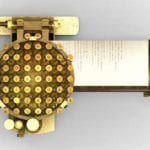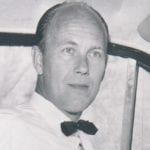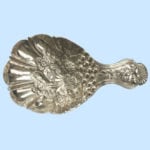 Humans
Humans  Humans
Humans  Gaming
Gaming 10 Overused Game Villains
 Mysteries
Mysteries Ten Mysterious “Ghost Ship” Stories That Still Keep Us Wondering
 Technology
Technology 10 Times AI Replaced Humans (and No One Noticed)
 Politics
Politics 10 Dreaded Despots Who Met Untimely Deaths
 Pop Culture
Pop Culture 10 Celebs Who Have Surprisingly Wanted to Be on Reality TV
 Creepy
Creepy 10 of the Strangest Popular Creepypastas
 Animals
Animals 10 Animals That Used to Be Bigger
 Our World
Our World 10 American Cities, Towns & Villages That Are Unlike Any Other
 Movies and TV
Movies and TV 10 Huge Movies Almost Made by Other Directors
 Humans
Humans 10 Real Life Versions of Famous Superheroes
 Gaming
Gaming 10 Overused Game Villains
 Mysteries
Mysteries Ten Mysterious “Ghost Ship” Stories That Still Keep Us Wondering
Who's Behind Listverse?

Jamie Frater
Head Editor
Jamie founded Listverse due to an insatiable desire to share fascinating, obscure, and bizarre facts. He has been a guest speaker on numerous national radio and television stations and is a five time published author.
More About Us Technology
Technology 10 Times AI Replaced Humans (and No One Noticed)
 Politics
Politics 10 Dreaded Despots Who Met Untimely Deaths
 Pop Culture
Pop Culture 10 Celebs Who Have Surprisingly Wanted to Be on Reality TV
 Creepy
Creepy 10 of the Strangest Popular Creepypastas
 Animals
Animals 10 Animals That Used to Be Bigger
 Our World
Our World 10 American Cities, Towns & Villages That Are Unlike Any Other
 Movies and TV
Movies and TV 10 Huge Movies Almost Made by Other Directors
10 Accidental Inventions That Changed The World
Sometimes, genius arrives simply by chance, not by choice. That explains why some of the greatest inventions happened by accident. In some cases, the inventor was searching for one thing but found something very different.
However, in one case, it was a casual walk through the woods that led to the discovery. Find out how chance played a role in some of the world’s greatest inventions.
10 Velcro
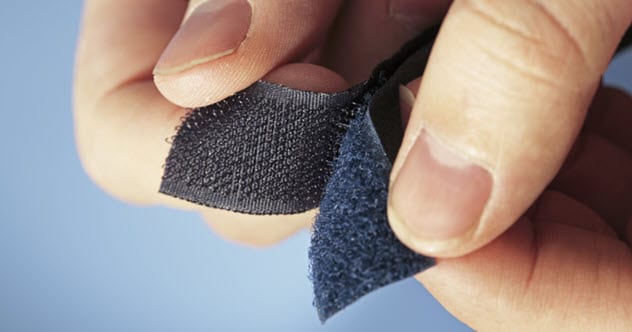
Velcro fasteners are on several products from backpacks to blood pressure gauges, but can you imagine a world where this technology doesn’t exist? Eighty years ago, people lived in a Velcro-less world with no plans or intentions of inventing the item.
In 1941, Swiss engineer Georges de Mestral took a leisurely stroll through the woods with his dog. When they returned from their walk, he noticed they were covered with small burrs. He studied the burrs in hopes of determining how they stuck to clothing and hair so easily, and he found that the small hooks on the burr allowed it to cling to tiny loops of fabric.
De Mestral came up with the bright idea of creating a two-sided fastener with stiff hooks and loops. He named his invention “Velcro,” which is actually the name of the company and not the general term for hook-and-loop fasteners.
His product was patented in 1955 and then manufactured and distributed across the world. Velcro fasteners have been used on several items, but they gained popularity after being used in outer space. The fasteners helped keep equipment from floating away in zero gravity. During de Mestral’s lifetime, his company sold an average of 55 million meters (60 million yd) of Velcro per year.[1]
9 Play-Doh

Kids love Play-Doh because it comes in many colors and can be sculpted into anything imaginable. This popular children’s product was invented by accident by Noah McVicker.
He worked for a soap company and originally invented the putty substance to be used as a wallpaper cleaner. The cleaner worked great because it contained no chemicals, could be reused, and didn’t stain the wallpaper.
Noah’s nephew, Joseph McVicker, worked for the same company and discovered that teachers were using the putty in their classrooms for arts and crafts. Joseph is responsible for changing the name to Play-Doh and marketing the putty for children.[2]
The McVickers established the Rainbow Crafts Company to manufacture and sell the putty, which at first was only available in an off-white color. More than 315 million kilograms (700 million lb) of Play-Doh have been sold since it was introduced. If you put all that putty through the Play-Doh Fun Factory playset, it would create a snake that could wrap around the world more than 300 times.
8 Post-it Notes

Sticky notes are just small pieces of paper used to help remind you that your doctor’s appointment is coming up or that your homework is late after tomorrow. We’re all guilty of using them, but it’s due to an accident that we are lucky enough to have them.
In 1968, Dr. Spencer Silver, a chemist at 3M, was attempting to create a superstrong adhesive. Instead, he accidentally created a very weak, pressure-sensitive adhesive. He promoted his “solution without a problem” within the company for five years, but nobody could come up with a use for it.[3]
In 1974, Art Fry, a colleague of Silver’s, found a way to use the adhesive for his personal purposes. Fry was a member of his church’s choir, and he was frustrated that bookmarks placed in his hymnal were always popping out. He used the adhesive on his bookmarks to hold them in place. Fry later had the idea of using Silver’s adhesive on small notes.
3M released the notes under the name Press ‘n Peel in 1977, but there was no immediate success. The company started testing the product in certain areas and released Post-it Notes in 1980.
The small sticky notes finally started to gain traction, and the rest is history. The notes are now sold worldwide and come in various shapes and colors.
7 Saccharin
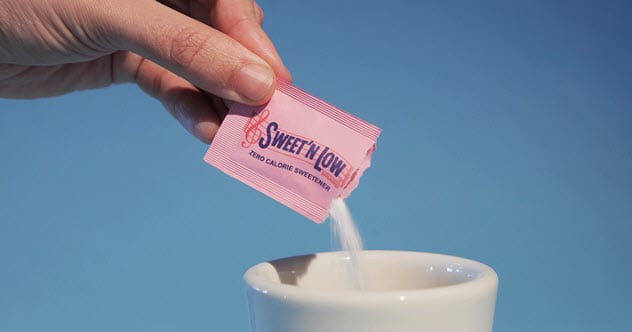
Outside of toxic lead(II) acetate, the first artificial sweetener was saccharin. The product offered a cheap alternative to cane sugar, and it was discovered entirely by accident.
The sweetener was discovered in a small lab at Johns Hopkins University that belonged to researcher Ira Remsen. He loaned the use of his lab to Russian chemist Constantin Fahlberg.
One night after working in the lab, Fahlberg went home to eat dinner with his wife. He noticed that the homemade bread he was eating was much sweeter, but his wife confirmed that she had not changed the recipe. Fahlberg realized that he must have transferred a chemical from his lab to the bread (and apparently, he hadn’t washed his hands).
He went back to his lab and tasted every chemical on his desk. Eventually, he traced the taste to a beaker filled with sulfobenzoic acid, phosphorus chloride, and ammonia (a compound known as benzoic sulfinide). This accidental discovery led to those little colorful packets that you see on every restaurant table.[4]
6 Vulcanized Rubber
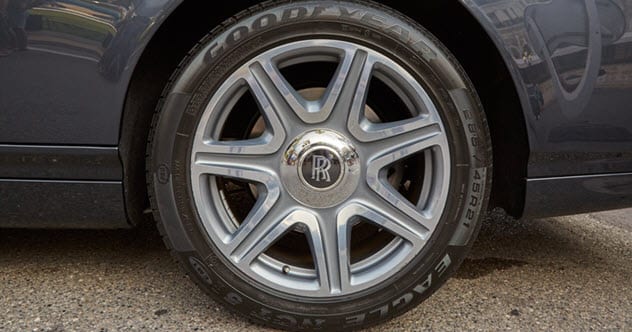
Charles Goodyear was obsessed with rubber—so much so that he put his family in debt to finance experiments to make rubber more suitable for industrial use. In his early years, he was unsuccessful in the rubber business, but he never let that slow him down.
In 1839, Goodyear accidentally dropped rubber on a hot stove with sulfur on it, and surprisingly, the rubber didn’t melt. In fact, it actually hardened.
In 1844, Goodyear patented the vulcanized rubber, and his company became a leading manufacturer of rubber at the time. His success was short-lived as was his fortune. He lost most of his money on legal battles fighting patent infringements, and he died in 1860. The Goodyear Tire & Rubber Company was founded in 1898 and named in his honor.[5]
5 Chocolate Chip Cookies

One of the most delicious treats, the chocolate chip cookie, was surprisingly invented by accident. It happened in 1930 at the Toll House Inn, which was run by Kenneth and Ruth Graves Wakefield. Mrs. Wakefield prepared all the desserts at the inn, and she had earned a reputation for her tasty treats.
One night, Mrs. Wakefield starting making some Chocolate Butter Drop Do cookies, which was a popular colonial recipe. But she realized that she was out of baker’s chocolate. So she started chopping up a block of Nestle semisweet chocolate to use in the recipe.
She thought the chocolate would melt and disperse across the cookie, but it actually retained its original form and softened. The cookie was a hit, and she dubbed it the “Chocolate Crunch Cookie.” The rest is sweet, delicious history. The original recipe is still printed on bags of Nestle’s Toll House Chocolate Morsels.[6]
4 Friction Matches

Matches have a long history, but the first friction match was accidentally invented by John Walker while conducting an experiment in his lab. First, he stirred a mixture of sulfur and other materials with a wooden stick. Later, he scraped the stick’s end with the dried material on the stone floor by accident.
The end of the wood burst into flames. He knew he had created something of amusement, so he made several more of the sticks to demonstrate for friends.[7]
Samuel Jones had seen one of Walker’s demonstrations and was encouraged to set up a match business in London. Jones’s product was named “Lucifers,” and its success caused smoking to gain popularity in the London area. This eventually led to the invention of the safety match, which can be found in most homes today.
3 Kevlar

Stephanie Kwolek always wanted to be a doctor. Instead, she became the accidental inventor of Kevlar, which is a lightweight fabric five times stronger than steel. While analyzing molecule chains at low temperatures, she found a chain that was exceptionally strong and stiff. She knew that fibers created from this solution were the strongest anyone had ever seen, and her discovery led to the invention of Kevlar.[8]
There are now more than 200 applications for the fabric. It has been used to create body armor for police forces and military troops, and it can also be found in planes, shoes, boats, car brakes, and many other items. Kevlar vests have saved many lives from bullets, knives, and other weapons, and many more in the future will be spared thanks to its discovery.
2 Glasses That Treat Color Blindness

In 2005, Don McPherson was out playing ultimate Frisbee when one of his friends asked to borrow his sunglasses. His friend was stunned when he put them on because they actually allowed him to see the color orange for the first time.
McPherson had just learned that his friend was color-blind. Created by McPherson, these glasses were originally made as eyewear for doctors during laser surgery. The surgeons loved the glasses so much that the specs began disappearing from operating rooms. McPherson also began to wear them casually, which is why he had them on that day.
McPherson and two colleagues later founded EnChroma Labs, a company that is dedicated to developing sunglasses for people with color vision deficiency. The company is continuing to study color blindness and how they can deliver glasses to consumers with different color deficiencies.
They are currently working on indoor glasses, a pediatric model, and an online test that can help people understand their color blindness. You can take the test here.[9]
1 Pacemaker
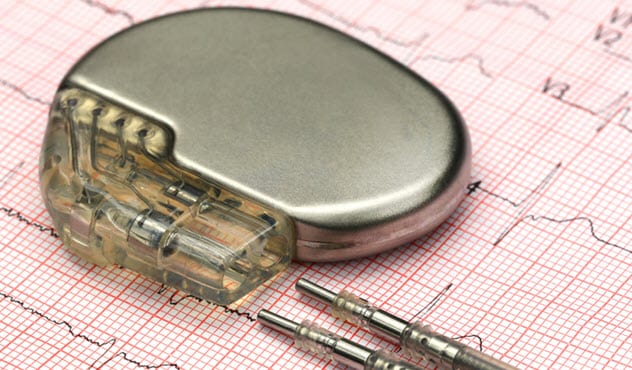
Dr. Wilson Greatbatch made an error that led to one of the greatest lifesaving inventions that would forever change health care. He attempted to create a heart rhythm recorder in 1956, but an incorrect electronic component caused him to fail.
Instead of recording the sound of a heartbeat, the device produced electronic pulses. That’s when Greatbatch realized that his mistake could help an unhealthy heart stay in rhythm by delivering shocks to help pump and contract blood.
After his accidental discovery, Greatbatch worked hard to produce the first implantable cardiac pacemaker. It took him two years to refine his device and receive a patent.[10]
His first pacemaker was implanted in a patient who lived 18 months with the device. His invention has ultimately saved millions of lives worldwide, and he proved that failure is the greatest learning experience.
I’m just another bearded guy trying to write my way through life. Visit me at www.MDavidScott.com.
Read about more accidental discoveries and inventions on Top 10 Accidental Discoveries and 10 Life-Changing Inventions That Were Discovered By Accident.
